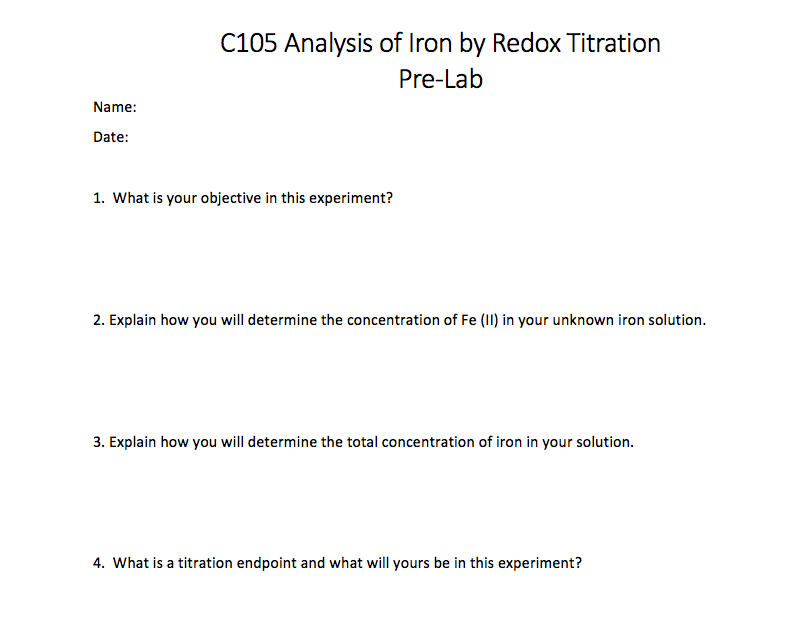INTRODUCTION
Many transition metal cations can have more than one possible charge (Worksheet 1). Differently charged species of the same element can have different chemical and physical properties. Knowing the charge can allow separation of the different ions based on their properties. For example, Cu2+ is blue and stable in solution, while Cu+ is colorless and reacts with oxygen. Hemoglobin contains iron as Fe2+ , but it is inactive at binding oxygen when the iron gets oxidized to Fe3+ . There are many similar situations in which it is important to always properly indicate charges of ions.
This laboratory experiment uses the difference in chemical properties of Fe2+ , iron(II), and Fe3+ , iron(III), to quantify the amount of each present in a solution of unknown concentrations of each. You will first determine the amount of iron(II) in your sample by titrating with a reagent that does not react with iron(III). You will then titrate a second sample after converting all the iron(III) to iron(II) in order to determine the total iron present. The percent composition of Fe2+ in the unknown mixture will be calculated.
BACKGROUND
The concentrations of both iron(II) and iron(III) ions in a solution can be determined by titration with potassium permanganate. The reaction is an oxidation-reduction reaction, or redox, for short. A brief introduction to oxidation-reduction reactions is given in the background of the âAcids and Basesâ experiment. The permanganate ion effectively oxidizes iron(II) to iron(III) in an acidic solution while being reduced to manganese(II) ion. The balanced net ionic reaction is:
5 Fe2+ (aq) + MnO4â (aq) + 8 H+ (aq) â 5 Fe3+ (aq) + Mn2+ (aq) + 4 H2 O(l)
Iron(III) is not oxidized by the permanganate ion, and thus does not react. Thus in order to determine the concentration of iron(III) ions, they must first be reduced to iron(II) ions. Zinc metal is used as the reducing agent, also under acidic conditions.
Zn(s) + 2 Fe3+ (aq) â 2 Fe2+ (aq) + Zn2+ (aq) (reduction of the Fe3+)
Zn(s) + 2 H+ (aq) â Zn2+ (aq) + H2 (g) (a side reaction that oxidizes excess Zn)
The Zn2+ formed does not interfere with the subsequent titration because Zn2+ is not oxidized by permanganate. Notice that converting all the iron(III) to iron(II) means that the total iron concentration ([Fe2+] + [Fe3+]) is titrated, not just the iron(II) originally present.
Techniques
This is a lab will utilize several of the techniques introduced in the experiment âLaboratory Techniques and Measurements,â the procedures for which are given in Appendix B. Poor laboratory technique and misuse of the glassware will result in poor data results, which will affect the grade you receive on the laboratory report. In order to use your time efficiently in lab, review how to properly:
rinse glassware prepare a standard solution use a volumetric pipette
weigh by difference set up and use a burette use a graduated cylinder
heat samples on a hot plate
Analysis of Iron by Oxidation-Reduction Titration
This lab uses the common quantitative technique of titration. The only difference between the titration you will be doing in this lab and that done in the Molar Mass of a Known Acid lab is the type of reaction used: this lab will use a redox reaction in place of the acid-base reaction performed in the previous experiment.
In order to determine the concentrations of iron(II) and iron(III) ions in a solution containing both ions, two portions of the same sample must be titrated separately. This first titration will determine only the iron(II) concentration. A second sample will be treated with zinc metal in order to reduce the iron(III) to iron(II). The resulting solution will be titrated with potassium permanganate. The result of this titration will give the total iron concentration in the sample. The difference between the first and second titration is the equal to the iron(III) concentration.
In this titration, potassium permanganate serves as its own indicator. The intense purple color of the permanganate solution becomes colorless when the permanganate is reduced to manganese(II). Thus, as iron(II) is oxidized with the addition of the permanganate solution from the burette it will impart a purple color that will fade. However, once there is no iron(II) left in solution a faint purple color will remain, marking the endpoint of the titration. This color can be slightly altered by the presence of iron(III), which is yellow in solution. Remember that iron(III) is generated by the reaction between iron(II) with permanganate, increasing the yellow appearance of the solution and which can interfere with the detection of the endpoint. Phosphoric acid is added to help minimize this effect.
pre lab questions:
C105 Analysis of Iron by Redox Titration Pre-Lab Name: Date: 1. What is your objective in this experiment? 2. Explain how you will determine the concentration of Fe() in your unknown iron solution. 3. Explain how you will determine the total concentration of iron in your solution. 4. What is a titration endpoint and what will yours be in this experiment?


